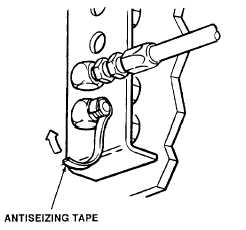|
| |
TM 5-2420-222-34
1-25.
LINES AND PORTS.
To keep dirt from contaminating fluid systems when removing and installing hydraulic, fuel, oil, and coolant lines,
perform the following steps:
(1)
Clean fittings and surrounding area before disconnecting lines.
(2)
Cover, cap, plug, or tape lines and ports after disconnecting lines. When these are not available, use
hand-carved wooden plugs, clean rags (Item 28, Appendix B), duct tape (Item 35, Appendix B), or other similar materials
to prevent dirt from entering system.
(3)
Ensure that new and used parts are clean before installing.
(4)
Wait to uncover, uncap, unplug, or remove tape from lines and ports until just before installing lines.
1-26.
ANTISEIZING TAPE.
Antiseizing tape (Item 34, Appendix B) may be used to keep
connections from leaking whenever you are connecting fuel, oil, and
hydraulic system lines and fittings without compression sleeves or packings
as follows:
(1)
Ensure that threads are clean and dry.
(2)
Start tape one or two threads from small or leading edge
of fitting, joining tape together with an overlap of about X in. (3 mm) for
fittings with fine threads. For fittings with coarse threads, tape should be
wrapped around threads two or three times.
(3)
Wrap tape tightly in same direction as you tighten a nut.
Tape must be pressed into threads without cutting or ripping
CAUTION
Do not exceed specified torque or use power tools to tighten fittings taped with
antiseizing tape. Overtightening could damage fitting threads and cause
connection to leak.
(4)
Using hand tools, tighten fittings to specified torque.
1-27.
TUBES AND COMPRESSION FITTINGS.
a.
Tubes with inverted nuts and compression fittings are designed for one-time assembly. Once assembled,
they must be replaced as a unit if any parts are found defective. Used parts may not seal properly when used with new
ones.
b.
Used tube assemblies in good condition can be Installed to their original location without leaking.
TA701215
1-13
|

